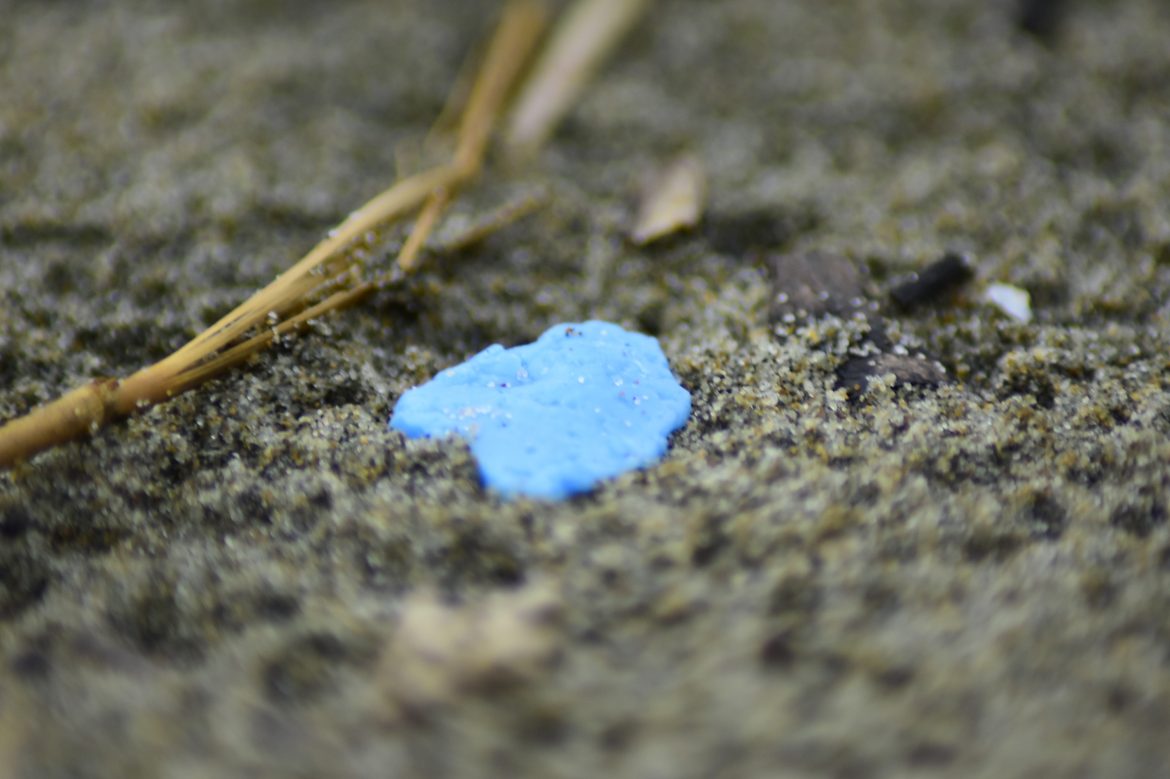
Where is All that Plastic?
Scientists have long been questioning not why there is so much plastic in the oceans, but why there actually is so little. This is because both the plastic wastes washing ashore and the plastic islands gathering on the ocean surface count for only 1% of the total amount of plastics poured into the seas. In other words, it is not even close to being the tip of the iceberg. So, where is the remaining 99%?
But first, here are some facts about plastic wastes:
Plastic is a very cheap and versatile, multi-faceted material. Exactly for these reasons, it has become a challenging environmental problem as the symbol of our “disposable” living style. Since the mass production of plastic products began about sixty years ago, the amount of produced plastics has doubled every 15 years, and it is estimated that we have used up a total of 8.3 billion metric tons of plastic material until now (the amount of plastics we produced and used in the last decade is more than the amount we did throughout history). Of these, 6.3 billion metric tons were disposed, and only 9% of this 6.3 billion was recycled. We may as well say that 91% of plastic wastes is not recycled.
And in the meantime, 79% of these wastes continue to dissolve as garbage in disposal sites or in the environment.
It takes up to 400 years for the majority of plastics to dissolve in nature, and studies suggest only 12% of total plastics is sent to the incinerators. Moreover, this process potentially adds another dimension to the problem, as its improper implementation leads to the release of greenhouse gases into the atmosphere.
According to estimates, 50% of plastic products are disposed after a single usage (materials used for packaging constitutes the 40% of total production). In other words, it takes a very short time for them to lose function and turn into waste (plastic cups, plates, bottles, packages, bags, etc.). Almost 150 million tons of plastic becomes “garbage” within 15 minutes of use every year.
Plastic packaging materials that become garbage do not only pollute the environment, they also consume the planet’s natural resources. Unfortunately, as consumers, we are blissfully unaware that producing a 1-litre PET bottles requires the consumption of 6 litres of water.
Revealing the total figures for plastic products that have been produced, disposed of, and burned, scientists are shocked by what they are witnessing.
The amount of plastic consumption increased so much that it exceeded the capacity of global waste systems, and began flowing into the oceans. According to the estimates, the amount of plastics in the oceans will largely surpass the total amount of fish by the middle of the 21st century.
Seas of Plastic
- More than 90% of all seabirds are flying around with plastic parts in their stomachs.
- More than 8 million tons of plastics are poured directly into the oceans every year.
Let’s go back to the plastics in the seas. If the plastics washing ashore and floating on the surface make up only 1%, where is this missing 99%?
Most studies focus on beaches and a shallow layer on the surface of the oceans, as these are relatively easy to observe. It is quite difficult to study other areas where plastics may accumulate, such as the bottom of the ocean and the water column between the sea bed and the surface (according to some studies, 70% of marine litter descends down to the deep-sea floor). In addition, some of these plastics end up in the stomachs of marine animals and the Great Pacific Garbage Patch *
We should not forget that most of these plastics in the sea are the microplastics, crumbled down to a size that is invisible to the naked eye. Sometimes, they may even be in the form of a water-soluble chemical rather than floating particles.
Scientists from the Monterey Bay Aquarium Research Institute have been studying the waters of San Francisco Bay by the US’s Pacific coast for two years, using remote-controlled submarines. They take water samples from different depths, and analyse them to determine the amount of plastic content. So far, they found about 15 pieces of plastics in each litre of water 200 metres below the surface (which is not much different from the plastic amount detected on the surface), and the traces of these invisible pollutants even at a depth of 1 km. Anela Choy, the leading researcher of the project, says “After two to three years of work, the honest truth is we have only one set of samples from one portion of the world’s entire ocean,” stating we are just at the beginning of the road.
A team analysing sediments from the bottom of Santa Barbara Basin off the coast of California, USA, detected microplastic fragments from the 1940s. Another research, carried out in 2017, estimates that 196 million tons of plastic may have settled down and into the sea bed since 1950. How this happened, however, is yet to be clear. Most commercially produced plastic usually floats due to low density. On the other hand, plastic may eventually descend to the bottom by attaching on to various other particles, moving with the turbulence caused by wind and waves, or entering the stomach of sea creatures. Yet another study by the same team predicts that all wildlife in all the seas of the world cumulatively contain approximately 100,000 tons of plastic at any given time.
A research team working on the North Atlantic “garbage patch” collected sea water samples from the surface down to a depth of 5 meters, at half-meter intervals, and compared the microplastic densities in this 5-meter column. They found that both numerical and mass concentrations of floating plastics decreased exponentially with water depth. However, even light winds may push tiny plastic particles deeper, and it takes some time until they ascend back to the surface –plus, most of them possibly get pushed deeper down. Therefore, studies investigating only the 10-20 cm layer below the surface may not be able to detect these smaller pieces. This, in turn, may mean that the microplastics floating invisibly just below the surface could constitute a significant portion of the missing 99%.

Source: The Ocean Cleanup. This Project investigates garbage deposits in the Great Pacific Garbage Patch with the help of a U-shaped floating trap, and has an assertive goal of cleaning them.
It is also difficult to identify the source of these buoyant microplastics. Still, the majority of plastic in Monterey Bay is possibly land-born, as they consist mainly of PET (polyethylene terephthalate) used in packaging materials.
Marine biologist Richard Thompson first coined the term “microplastic” in 2004, to describe plastic fragments smaller than 5 millimetres in length, and asserted the possibility that deep seas may be containing tremendous amounts of it.
We must add, that the problem is not limited to the seas. Would you be surprised if we told you that in 2019, an average of 365 pieces of microplastic per square meter were found on a daily basis in the Pyrenees Mountains, the world-renowned Southern French scenery famous for its natural beauty and clean air? Plus, this plastic rains down from the sky, simply because it can be transported over very long distances with the help of atmospheric air currents.
And now, we also have the nanoplastics. These are the plastic particles smaller than one thousandth of a millimetre, that is, even smaller than a single living cell. They are completely invisible to the naked eye, and can only be detected by using special equipment. So small, that they can accumulate in the blood and cell membranes of various organisms. One study even observed them crossing the blood-brain barrier. They are known to cause toxic damage by affecting the nervous, reproductive, and the endocrine systems.
A waiting-to-be-published study, which covers the entire coastline of Australia in 2020, suggests that most of the plastic is trapped close to the shore, and this amount is much more than expected. Especially near urban areas where rivers meet the ocean, our trash is more likely to be trapped by waterways before it gets to the sea. According to a study by Greenpeace, specimens taken from the Mersey River in the UK indicate that this river is more polluted than the Great Pacific Garbage Patch (875 pieces of plastic were detected in samples collected in just half an hour).
The only way to prevent this enormous amount of plastic waste, regardless of its origin and the place where it collects, is to resist using these plastics to begin with. Some of the suggestions listed by the World Wildlife Fund (WWF) and other environmental organizations on reducing plastic usage/consumption are:
- Carry your own reusable tea/coffee cups
- Carry a reusable water bottle
- Avoid the usage of plastic forks, spoons, and plates
- Avoid using plastic straws
- The aluminium foil we use in the kitchen can be recycled, but plastic stretch wraps cannot be recycled, prefer reusable ones
- Do not use tea bags
- Avoid chewing gum, as almost all of them are plastic
- Stay away from glittery products, as they contain microplastic
- Buy milk and other beverages in glass bottles
- Carry cloth bags with you for shopping, instead of using plastic bags
- Use matches instead of lighters
- Do not buy processed food sold in plastic packages
While these measures will not solve the plastic waste problem completely, they are important steps in changing our consumption habits on a global scale. In line with the “supply and demand” principle, products not preferred by consumers will perish over time. Even if our personal efforts will not be enough to eliminate most of the sources of industrial waste, we can at least change our consumption habits that we have control over.
* The Great Pacific Garbage Patch: It is the largest pile of floating trash in the world, found between Hawaii and California in the USA, and is often described as being “larger than the state of Texas”. It was discovered in 1997 by a sailor named Charles Moore, and was named by the oceanographer Charles Ebbesmeyer. In terms of the number of pieces, 94% of it is estimated to consist of microplastics, but these microplastics make up for only 1% of the total plastic in weight. Fish nets account for 46% of it, and a large portion of the rest of it consists of various other fishing equipment. Scientists propose that 20% of the plastics floating in the Great Pacific garbage patch were carried to the sea as a result of the great tsunami that happened in Japan in 2011.
REFERENCES
- 1. https://plasticoceans.org/the-facts/
- 2. https://www.nationalgeographic.com/news/2017/07/plastic-produced-recycling-waste-ocean-trash-debris-environment/
- 3. https://www.theguardian.com/us-news/2019/dec/31/ocean-plastic-we-cant-see
- 4. https://cosmosmagazine.com/earth-sciences/scientists-have-found-the-missing-plastic-from-our-oceans?utm_source=Cosmos+-+Master+Mailing+List&utm_campaign=9ee62a4bce-EMAIL_CAMPAIGN_16_MAR_2020&utm_medium=email&utm_term=0_3f5c04479a-9ee62a4bce-180744937
- 5. https://www.nationalgeographic.org/encyclopedia/great-pacific-garbage-patch/
- 6. https://www.iflscience.com/environment/missing-plastic-oceans-can-be-found-below-surface/
- 7. https://caseagrant.ucsd.edu/news/explosion-in-plastic-pollution-post-world-war-ii-seen-in-marine-sediments
